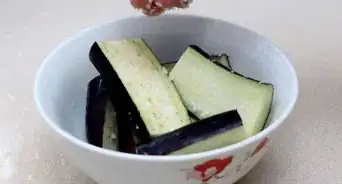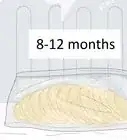This article was co-authored by Jennifer Levasseur. Chef Jennifer Levasseur is a Personal Chef and the Owner of The Happy Cuisiniere based in Breckenridge, Colorado. She has over 12 years of culinary experience and specializes in Mountain and Contemporary Rustic cuisine. Moreover, she can craft dishes and modify menus to accommodate dietary restrictions, such as gluten-free, vegetarian, vegan, pescatarian, and dairy-free diets. In addition to a Bachelor’s degree in Marketing and Management from the University of Houston, Chef Jennifer holds Associate’s degrees in Culinary Arts and Baking & Pastry Arts from Houston Community College.
This article has been viewed 61,815 times.
Salting an eggplant can make it less bitter, which is especially important for older eggplants. Salting can also help the eggplant absorb less oil, particularly when you're frying it, and it helps flavor the eggplant by allowing it to pull salt into the vegetable. You have two basic methods you can use, salting it dry and soaking it in saltwater.
Ingredients
- Eggplant
- Salt
- Water (optional)
Steps
Salting the Eggplant Dry
-
1
-
2Add salt. You'll need a lot of salt for this process, so use more than you think you need, about 1/2 tablespoon for each (medium) eggplant. You can use regular table salt, kosher salt, or whatever you have on hand.[3] Sprinkle the salt on, or toss the cubes in the salt. Spread the cubes out in a colander or over a cooling rack, as water will drip off them.[4]
- A medium eggplant is about a pound by weight. If you're eggplant is larger or smaller, adjust the amount of salt in the same ratio. For instance, if you have an eggplant that is 1 1/2 pounds, add 3/4 tablespoon of salt for each eggplant.
Advertisement -
3Let the cubes rest. This process takes time, as the salt is drawing moisture out of the eggplant. You'll need 30 minutes at the minimum, but you can leave them up to an hour and a half. Watch for moisture beading up on the eggplant, which is what you want.[5]
-
4Rinse the salt off. Run the eggplant under water for a minute or two, making sure you get most of the salt off. Leaving too much salt on will make the final dish too salty.[6]
-
5Press the eggplant dry. For most applications, you want to dry the eggplant off as much as possible. Place the eggplant between two paper towels, and press it down on a hard surface with your hand, which will remove much of the water. Use immediately.[7]
Soaking Eggplant in Saltwater
-
1Cut the eggplant. If you're using small eggplants (such as Japanese eggplants, which are about the size of a small apple), you can simply peel some of the skin off (about half of it in stripes), or poke holes in it with a fork. For larger eggplants (such as the typical American ones that weigh in at a pound), cut it into cubes or slices, whatever you need for the final dish.[8]
-
2Create your saltwater. Get a bowl big enough for the eggplant to soak in. Add room-temperature tap water to it, leaving room for the eggplant. Pour in salt. You'll need about a tablespoon per cup or two of water. Mix it up to dissolve the salt.[9]
-
3Soak the eggplant. Place the eggplants in the bowl. Mix the water and eggplant around to get the process started. Leave the eggplants to soak in the water. You'll want them to soak for about 30 minutes or so. Drain the water off at the end, but you don't need to rinse the eggplant off with this method.[10]
-
4Pat dry. Before cooking, you should pat the eggplant dry between paper towels. It can help to press down slightly on it to release a bit of the water. Use the eggplant immediately.[11] This method works especially well before frying eggplant since it will crisp up more evenly.
References
- ↑ http://www.finecooking.com/article/how-to-cook-eggplant-to-tender-silky-perfection-2
- ↑ https://www.exploratorium.edu/cooking/icooks/ask.html
- ↑ http://www.thekitchn.com/soggy-bitter-eggplant-just-add-salt-173792
- ↑ http://www.finecooking.com/article/how-to-cook-eggplant-to-tender-silky-perfection-2
- ↑ http://www.thekitchn.com/soggy-bitter-eggplant-just-add-salt-173792
- ↑ http://www.finecooking.com/article/how-to-cook-eggplant-to-tender-silky-perfection-2
- ↑ http://www.thekitchn.com/soggy-bitter-eggplant-just-add-salt-173792
- ↑ http://www.finecooking.com/article/how-to-cook-eggplant-to-tender-silky-perfection-2
- ↑ http://www.epicurious.com/expert-advice/do-you-really-need-to-salt-eggplant-article
Community Q&A
-
QuestionCan I salt eggplant and leave it overnight?
 StephInfectionCommunity AnswerWith the soaking method you can put them in the fridge overnight. With the salt only method the eggplant will oxidize and turn brown after a while.
StephInfectionCommunity AnswerWith the soaking method you can put them in the fridge overnight. With the salt only method the eggplant will oxidize and turn brown after a while.
Things You'll Need
- Knife
- Fork
- Colander or cooling rack
- Bowl
- Paper towels
About This Article
To salt eggplant, start by cutting them into slices or cubes, then add ½ tablespoon of salt per 1 whole eggplant. Toss the cubes or slices with the salt, and let them rest for 30 minutes, or until you see moisture beading up on the surface. Then, rinse off the salt under running water for 1 minute, and press the eggplant dry between 2 paper towels. Alternatively, soak the eggplant in a bowl of saltwater for 30 minutes, then pat them dry with paper towels. For helpful tips, like how to adjust the amount of salt based on the size of the eggplant, scroll down.





















































